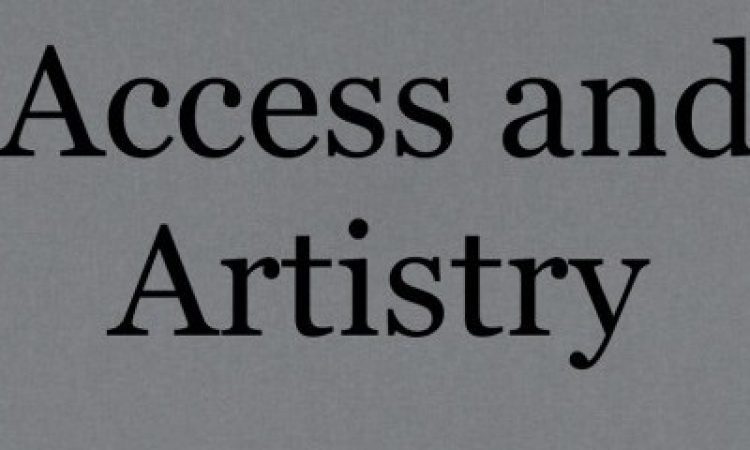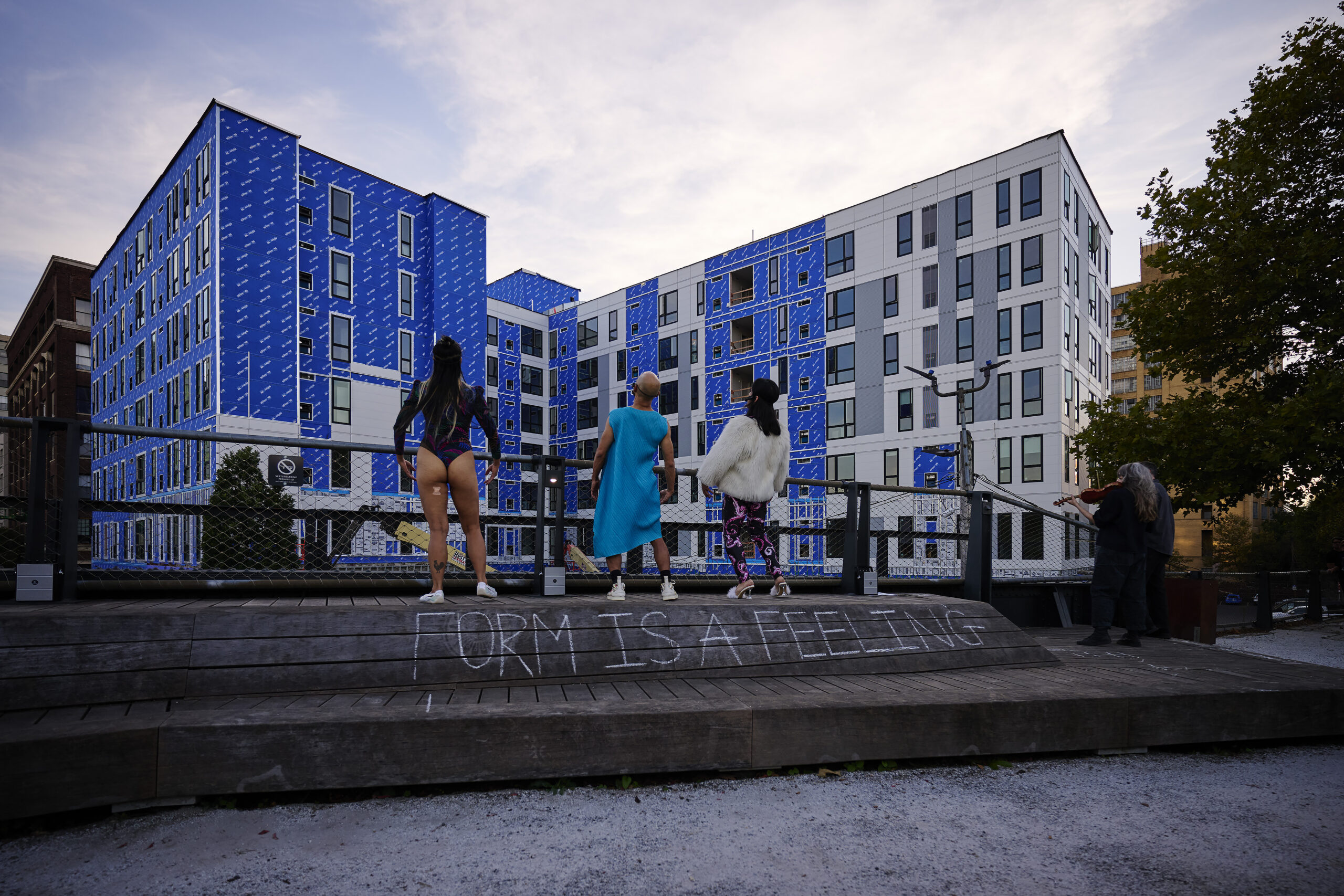To focus a lens on accessibility in performing arts, this interview series highlights the experiences of working artists and audience members with disabilities. My hope is that it generates conversations about access and inclusivity and works to decenter ableist methodologies in the field. I first spoke with blind ballerina and dance educator Krishna Washburn about her teaching platform Dark Room Ballet, blind technique, and dance experience.
Emilee Lord: I began studying Audio Description last fall. While researching AD specifically for dance, I discovered you and Dark Room Ballet. Where do we begin?
Krishna Washburn: Well, I care about blind people, and I care that blind people have art to interact with, and I want blind people to be happy. Every decision that I make comes from that understanding. And also, there’s a misunderstanding that dance is fundamentally a visual medium. It isn’t. Dance is a somatic, visceral medium.
EL: And your focus is ballet, specifically?
KW: Dark Room Ballet is a preprofessional program, and as far as I know, it’s the only preprofessional program for blind and visually impaired adults taught in the English language. And do you know what ballet actually is? It is the dance system that prioritizes balance above all other movement priorities. That’s what ballet is. It is useful because it helps to suspend disbelief when telling stories involving magic and the supernatural.
EL: Where does Audio Description come in?
KW: Why do you go to a dance performance? Is it to look at something? I don’t really think so. Because when you speak with people about memories of dance performances, what they remember is the emotional experience, right? Because dance allows you to be inside another person’s body and feel what they feel, both visceral and emotional. I dance and speak simultaneously because I only perform for my students as a blind performer performing for blind people. Self Audio Described Dance. That’s my whole thing. It’s, of course, a pedagogical style and also an artistic style. I don’t know what I look like. I haven’t known what I look like for about 20-something years. And I don’t care. But my students, as they listen to me, can move their bodies along with me as I describe. They can feel what I feel, and they’re not missing anything. They’re getting all the pieces that they want from art. They get welcomed into my corpus. Come be in here with me, and we’ll do this together. Feel the nerve. Pull through the index and middle finger as we reach it away. It’s like, where in your body do you notice it? Does it engage with a certain emotion for you when you are doing the movement?
EL: I’m thinking about that in my dance education background and how I teach choreography. It’s a look and copy relationship without much language. We don’t train dancers to be able to say what they’re doing. When I’m trying to explain further, to get something out of a dancer, that vocabulary I think comes more from my years as a writer and educator, oddly not from the dance itself.
KW: Yeah, I understand. We don’t teach dancers about things like that. That’s a mistake. I really believe that teaching all dancers self description skills is invaluable. But blind people need that. That’s our educational need. That’s our access need. My blind teacher changed my life. To be loved by another blind person who understood me, who told me I could dance like myself. And I got my blind technique. Now I teach blind technique. Sighted people show up; they listen to me. If they’re a real ballet person, they’re horrified because it’s not what that Russian lady told them, right? *laughs* But sighted people without a dance background will learn a lot. Blind technique works equally well for blind and sighted people. The sighted technique only works for sighted people. Look, artistry comes from our specific experience that can be added to the pedagogy and the way work is made.
EL: I read this report, Disability Equity In NYC’s Arts and Culture Landscape, by Simi Linton and Kevin Gotkin, and it talks about how when considering accessibility, we need to distinguish between what we do for an audience in a space and what we’re doing for the artists, and how we’re inviting work.
KW: Both of those things are important. I think there’s still the assumption that all the performers will be nondisabled people. It’s the same with educators. When I look for resources for disabled teachers, I only find resources for teachers with disabled students. So Ableism has shaped my life in every possible way. People don’t think I’m a real person or think I’m as valuable as they are. The bad part of being a disabled person is the way that people treat me, right? And that is what I suffer. I don’t suffer not being able to see; I suffer because people wish I could see. My experience is not incomplete and is just as valid as anyone else’s. I hate the word “inspiration,” and I hate the word “cute.” I am neither of those things. I’m a 41-year-old dance education professional.
EL: Right. So tell me more about your class and your methods.
KW: Do you know what we use instead of a mirror? We use tape on the floor. Blind dance history remains largely in the oral tradition, so it’s hard to study. The tape method, I believe, comes from Japan. Japan has a longer tradition of blind dance student training than the United States. Or let’s talk about what you need to do to maintain your posture. And why is this different? Because sighted people teach this front body orientation. We fall like a dying tree in the forest when we do that. We have to balance from the back of the body; sighted people can do it just fine, by the way.
EL: These techniques could be integrated into all dance classrooms if we decentered the sighted experience.
KW: In general, yeah. I’ve often had to be my own teacher, and learning things has taken me longer. No other blind student should have to experience that. I think that’s crap. At the end of every one of my classes, we have question and answer time. I have a little transition reverence at the end of class, a memory exercise where I remind people that their memories are just as real as anyone else’s because people love to gaslight blind people. And then I let them be blind people asking blind people questions.
Another example of something everyone could use but that comes from the blind community is this: I give my students a vocabulary email before every class, every ballet word I will be using, so they can refresh it before they come into class. And I wrote most of those definitions myself because the dance dictionaries aren’t really meant for students. They’re meant for teachers and choreographers who already know what they are. They don’t actually explain it from the rudiment. So I have now written the first ballet dictionary in English for students. And it came about because of my blind community. We’re doing a unit on soutenu right now talking about how soutenu can be used to take a dancer in an infinite number of directions in space and how that works. Every definition of soutenu you’ll find in any dictionary will say it’s a turn in sous-sus. And that’s it. One thing is defined by something that requires its own definition. And by the way, I don’t think there is any sous-sus in soutenu.
EL: You’ve told me before that you performed a lot but never wanted to be a performer. And you’ve referred to exploitative performance. Will you say more about that?
KW: So most of the work being done is still to impress and please nondisabled people. I don’t care to please or impress. I only care about blind people and what they want and need. Blind Dance Technique, Audio Description for Dance, self description, these could change the world. That’s why I’m here. That’s why I exist. I get very little grant money, but my classes are free. I have class twice a week, Monday and Saturday, every week until I die. I don’t get paid to write. I don’t get paid to prep. I don’t have any sub either. It’s just me. When I die, I’m going to be replaced by many. I want that. I will have changed the dance landscape just through my efforts. Even though we demean the teacher and say, “That’s what you do if you don’t make it in your performance career, or can’t get a good choreography gig,” or what have you. But no, it’s the most powerful dance job because you’re making the future. And blind people are a part of that future.
*This interview was held over Zoom on March 22, 2023. It has been edited and condensed for length and clarity.






